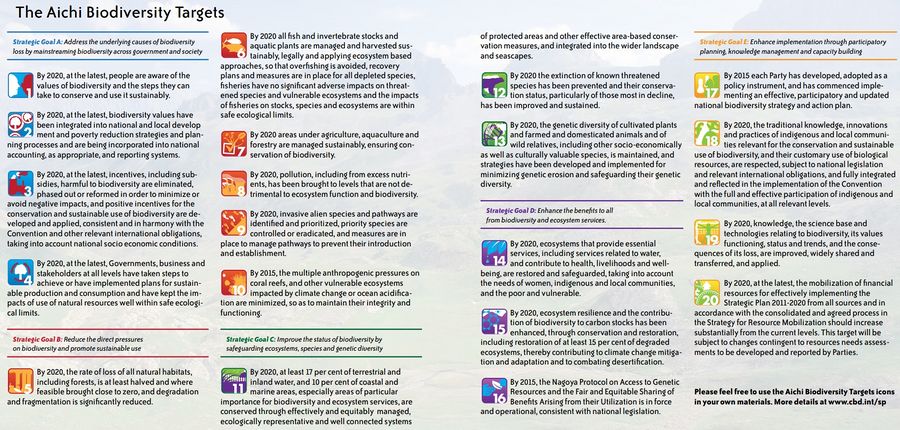Convention on Biological Diversity
Biological diversity - or biodiversity - is the term given to the variety of life on Earth and the natural patterns it forms. Biodiversity is the fruit of billions of years of evolution, shaped by natural processes and, increasingly, by the influence of humans. It forms the web of life of which we are an integral part and upon which we so fully depend.
Contents
Introduction
Biodiversity is often understood in terms of the wide variety of plants, animals and microorganisms. So far, more than 200,000 marine species have been identified, mostly small creatures such as insects. Scientists believe that the number of marine species living on earth is of the order of one million, see Number of marine species. Biodiversity also includes genetic diversity (genetic variation that occurs among members of the same species), ecosystem diversity (variety of biological communities) and functional diversity (variety of biological processes, functions or characteristics). Biodiversity provides ecosystem goods and services that sustain our lives.
The Convention on Biological Diversity
The Convention on Biological Diversity (CBD) was signed by 150 government leaders at the 1992 Rio Earth Summit, and is dedicated to promoting sustainable development. The CBD was conceived as a practical tool for implementing the principles of Agenda 21. Biological diversity is defined as more than plants, animals and micro-organisms and their ecosystems. It also is about people and their need for food security, medicines, fresh air and water, shelter, and a clean and healthy environment. Biodiversity underlies the goods and services provided by ecosystems that are crucial for human survival and well being. Ecosystem goods and services have significant economic value, even if some of these goods and most of the services are not traded in the market and thus are not priced to inform society to changes in their supply or in the condition of their ecosystems.
At the 1992 Earth Summit in Rio de Janeiro, world leaders agreed on a comprehensive strategy for "sustainable development" -- meeting human needs while ensuring a healthy and viable world for future generations. One of the key agreements adopted at Rio was the Convention on Biological Diversity. This pact among the vast majority of the world's governments sets out commitments for maintaining the world's ecological underpinnings as we go about the business of economic development. The Convention establishes three main goals:
- the conservation of biological diversity,
- the sustainable use of its components, and
- the fair and equitable sharing of the benefits from the use of genetic resources.
Aichi Biodiversity Targets
At the tenth meeting of the Conference of the Parties, held from 18 to 29 October 2010 in Nagoya, Japan, a revised and updated Strategic Plan for Biodiversity was adopted. This Plan provided an overarching framework on biodiversity, not only for the biodiversity-related conventions, but for the entire United Nations system and all other partners engaged in biodiversity management and policy development. Core elements of this plan were the Aichi Biodiversity Targets (see poster below).
Target 11 states that by 2020, at least 10% of coastal and marine areas, especially areas of particular importance for biodiversity and ecosystem services, are conserved through effectively and equitably managed, ecologically representative and well connected systems of protected areas and other effective area-based conservation measures, and integrated into the wider landscapes and seascapes. Although there is progress, the realization of this target in 2020 is still far behind, see Marine Protected Areas (MPAs). The realization of other targets related to the marine environment (sustainable fisheries, ecosystem restoration and resilience and knowledge, science and technology) also falls short.[1] Ecosystem protection and restoration are vital to mitigate the effects of climate change in marine biodiversity.
Links between biodiversity and climate change
The links between biodiversity and climate change are outlined in the Report on the Interlinkages Between Biological Diversity and Climate Change[2]. Past changes in climate resulted in major shifts in species ranges and marked changes in biological communities, landscapes, and biomes. The current levels of human impact on biodiversity are unprecedented, and causing large-scale loss of biodiversity. For a given ecosystem, functionally diverse communities are more likely to adapt to climate change and climate variability than impoverished ones[2].
Extensive work has been completed at global and regional levels on impacts of climate change on marine biodiversity; a review is presented in: IPCC Special report on the ocean and cryosphere in a changing climate CH05: Changing Ocean, Marine Ecosystems, and Dependent Communities (2019[3] . One of the main findings is: Ocean warming has contributed to observed changes in biogeography of organisms ranging from phytoplankton to marine mammals (high confidence), consistently changing community composition (high confidence), and in some cases, altering interactions between organisms (medium confidence).
References
- ↑ Carr, H., Abas, M., Boutahar, L., Caretti, O.N., Chan, W.Y., Chapman, A.S.A., de Mendonca, S.N., Engleman, A., Ferrario, F., Simmons, K.R., Verdura, J. and Zivian, A. 2020. The Aichi Biodiversity Targets: achievements for marine conservation and priorities beyond 2020. PeerJ 8:e9743
- ↑ 2.0 2.1 Secretariat of the Convention on Biological Diversity (2003). Interlinkages between biological diversity and climate change. Advice on the integration of biodiversity considerations into the implementation of the United Nations Framework Convention on Climate Change and its Kyoto protocol. Montreal, SCBD, 154p. (CBD Technical Series no. 10) https://www.cbd.int/doc/publications/cbd-ts-10.pdf
- ↑ Bindoff, N.L., W.W.L. Cheung, J.G. Kairo, J. Arístegui, V.A. Guinder, R. Hallberg, N. Hilmi, N. Jiao, M.S. Karim, L. Levin, S. O’Donoghue, S.R. Purca Cuicapusa, B. Rinkevich, T. Suga, A. Tagliabue, and P. Williamson, 2019: Changing Ocean, Marine Ecosystems, and Dependent Communities. In: IPCC Special Report on the Ocean and Cryosphere in a Changing Climate [H.-O. Pörtner, D.C. Roberts, V. Masson-Delmotte, P. Zhai, M. Tignor, E. Poloczanska, K. Mintenbeck, A. Alegría, M. Nicolai, A. Okem, J. Petzold, B. Rama, N.M. Weyer (eds.)]. https://www.ipcc.ch/srocc/chapter/chapter-5/
See also
Library and documentation of the CBD secretariat
Please note that others may also have edited the contents of this article.
|

